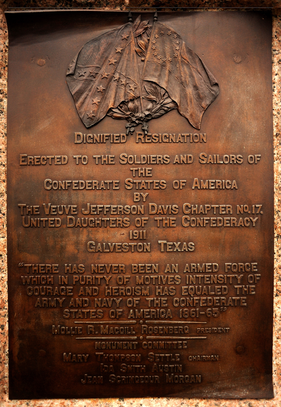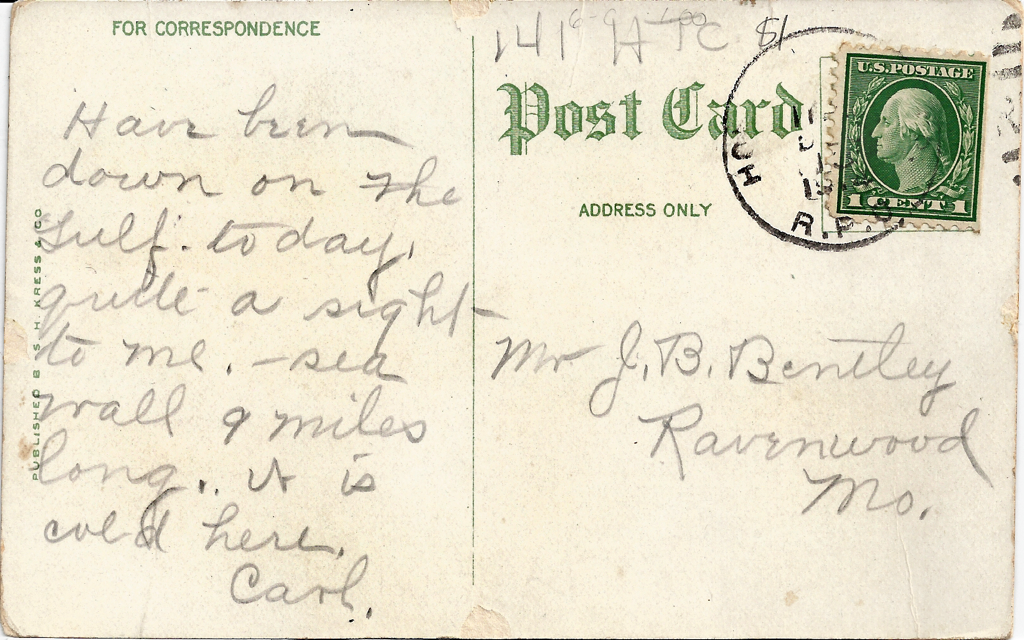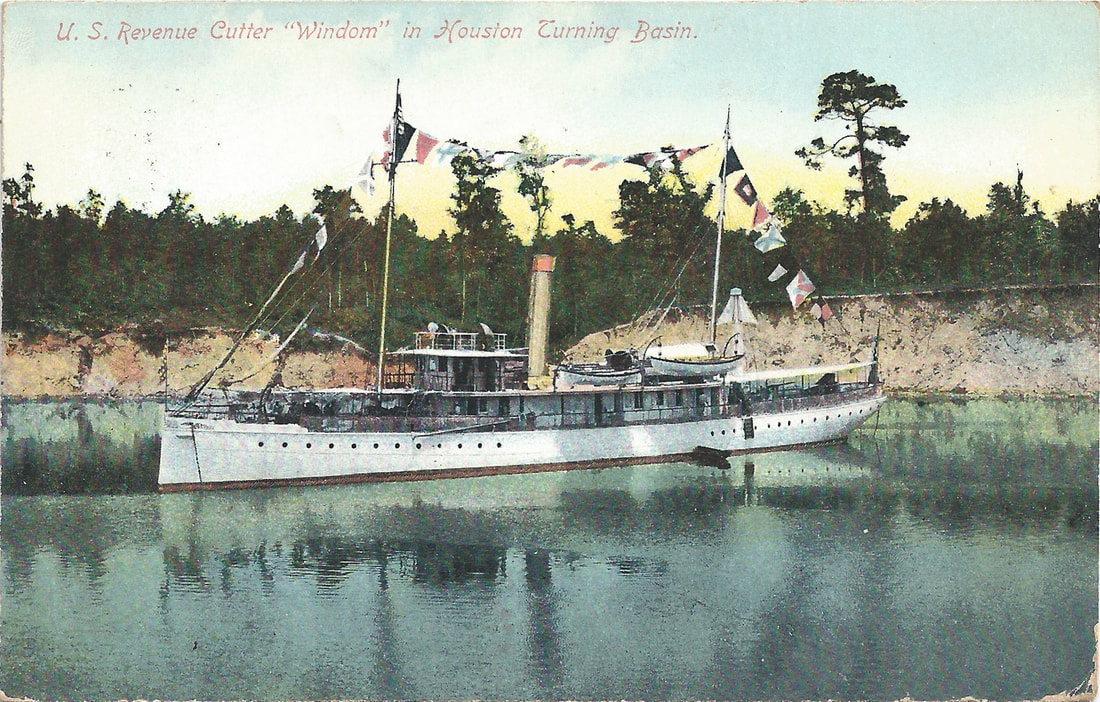Confederate Monument
|
13 December 1914: 716 21st Street: Galveston County Courthouse, 4 floors, 1899 was the fifth courthouse in the county originally chartered by the Republic of Texas in 1838 from colonial counties of Harrisburg, Liberty and Brazoria.
|
23 March 2019: 722 21st Street: The 1899 courthouse was demolished in 1966 and this bland courthouse was built astride the 20th street right of way, 5 floors, 1966.
|
|
Postmarked: 13 December 1914; Hou[…] R. P. O.
Stamp: 1c Green George Washington #405 To: Mr. J. B. Bentley Ravenwood, Mo. Message: Have been down on the Gulf today, quite a sight to me. -sea wall 9 miles long. It is cold here. Carl. Carl was Henrietta Caroline “Carl” Bentley, daughter of the recipient, Joel Battles Bentley and wife of Ira Ashley Goodson, a lumberman in Ravenwood, a small community of less than 350 in Nodaway County, MO, about halfway between Omaha and Kansas City. She was apparently visiting Galveston, perhaps with her husband on a business trip to southeast Texas where the lumber business was among the most important. If they were on more of a leisure trip, they could have brought their children, Glen, age 12; Katherine, 9; Ira, Jr., 6; and Grace, 2 but she makes no specific mention of them.
Caroline’s mother, Elizabeth Jane Foot, had died almost 20 years earlier, and J. B. had not remarried, but when she died in 1896 all the children were grown or teenagers: Sarah Evelyn Bentley was 25 and married to Charles Joseph Funk; Caroline was 21, Eda Belle was 19, and Martin was 14. Elizabeth was the daughter of William C. Foot (1826-1898) and Harriett Vestal (1829-1870), who settled in Poweshiek County, IA shortly after their marriage on 23 August 1850 in Surry County, NC, then to Nodaway County about 1868. Caroline’s father Joel was born in Trumbull County, OH in 1840, and after 1860 came to Missouri volunteering on April 1, 1862 for a 3 year tour of duty in the Civil War in the 4th Missouri State Militia Cavalry. His oldest brother, Amos Baldwin Bentley (b. 1822), had already moved to Nodaway County by 1860, and his son, James H. Bentley (b. 1844), joined the same company of the 4th Missouri State Militia Cavalry (both Bentleys achieving the rank of Corporal). The unit served in Missouri protecting railroads, guarding various cities and towns, and resisting Confederate raiders Quantrell and Shelby. |
The Bentley family, Amos, Anson Green (b. 1824), Caroline (1826), Evelyn (1830), Martin (1833), Benjamin F. (1837), and Joel Battles Bentley were the children of James Bentley (1798-1890) of Mercer County, PA and Temperance Battles (1799-1887) of Hartford County, CT, coming to Ohio in the early 1820’s. After service in the Civil War, Joel married Elizabeth J. Foot on 29 November 1868 in Nodaway County, and settled in as farmer-merchants, living out their lives there. When Joel died in 1919 his estate was split equally between his children, with unmarried Eda Belle retaining the house and $1000, Martin named as executor.
Carl and Ira were married in Nodaway County on 21 December 1899 where his father Madison Goodson (1844-1933) and mother Scioto Ann Hampton (1850-1941) were also living. Like the Bentley boys, Madison was a Civil War Veteran, serving in Company B, 149th Ohio Infantry from 2 May 1864 until 30 August 1864, then discharged because he was discovered to be only 17. Soon after his 18th birthday on 8 September he re-enlisted and served until the end of the war. Moving to from Clinton County, OH to Lewis County, MO in 1867, he taught school there, returning to Ohio briefly to marry Scioto Hampton on 28 December 1868. They had five children: Eugene (1870), Ira Ashley (1872), Ruth (1874), Grace (1880), and Frankie (1892). Madison moved from Knox County to Nodaway County in 1873 where he continued farming and teaching until 1900 when be bought a lumber business. Madison was highly literate and responsible, serving as census enumerator on the 1880 census, and as Mayor of Ravenwood when called upon by the citizens. His son Eugene was very much like his father, and served as enumerator on the 1900 census. Ira and Carl remained in Ravenwood where he owned and operated a lumber store. His parents stayed close by, as did Harriet’s sister Eda B. Bentley. His father Madison died in 1933 and his mother Scioto in 1941, they are buried in Oak Lawn Cemetery in Ravenwood, as was his brother Eugene Goodman (1870-1930). Ira’s sister Ruth moved to Eagle County, CO where she taught public school, married Oliver S. Nisja and raised a family there; they are buried in Greenwood Cemetery in Red Cliff, CO. Two other sisters, Clara Grace Goodson (1880-1968) and Frankie Wyche Goodson (1892-1970) married brothers Dorsey Marvin Bishop and Emmett Floyd Bishop, sons of Dr. Elijah Washington Bishop (1847-1935) of Nodaway County. Grace is buried in Gentry County, MO and Frankie is buried in Phoenix, AZ. Joel Battles Bentley (1840-1919) and Elizabeth Jane Foot Bentley (1853-1896) are buried in Sweet Home Cemetery in Ravenwood. Ira died in 1944 and Carl died in 1950, they are buried near his parents, as well as his sister Eda Belle Bentley (1876-1951), and brother Martin L. Bentley (1881-1956). Carl’s sister Sarah Eveline Bentley Funk (1870-1949) moved to Sterling, Logan County, CO where she is buried in Riverside Cemetery near her husband Charles Joseph Funk (1865-1945). |

|
The caption reads “Freedom” in City Park, Galveston, Texas, but a 21st century viewer might ask, "Freedom for whom?". The bronze statue by Louis Amateis, commissioned for a similar Houston statue in 1908, was dedicated June 3, 1912 to honor the soldiers and sailors of the confederacy. The soldier holds a rolled-up confederate battle flag over his left shoulder and a broken sword in his trailing right hand. Behind him is a dismantled cannon with a cannonball balanced on top, and under the cannon is an anchor on a bed of foliage, perhaps a tribute to Galveston’s maritime role in the Civil War. On the ground between the soldier’s feet is a scroll inscribed "Glory to the Defeated." Galveston had been, in fact, more of a victory for the cause, an important southern port, blockaded and then taken by Union forces. It was soon retaken by the rebels and at the end of the Civil War the only major port held by the south. Among the Union ships seized by the rebels was the Harriet Lane, whose bell was ultimately taken to Houston and saved as a monument in Sam Houston Park [See Harriet Lane].
Entitled “Dignified Resignation,” the 1911 dedication reveals that The Veuve Jefferson Davis Chapter of the United Daughters Of Confederacy embedded the plaque in the Texas granite base. The plaque reads "There has never been an armed force which in purity of motives intensity of courage and heroism has equaled the Army and Navy of the Confederate States of America 1861-65." The president of the Galveston DOC was Mollie R. MacGill Rosenberg (1839-1917), second wife of Swiss-born Henry Rosenberg (1824-1893), Galveston business leader and philanthropist. Mollie’s father and four brothers fought for the confederacy and she herself nursed the wounded in their Richmond Virginia home. She came to Galveston after the war to nurse Rosenberg’s ailing first wife, Letitia, a friend of her parents. Letitia died on June 4th 1888 and she and Henry were married 13 November 1889. In 1895 she founded the Galveston chapter of the Daughters of the Confederacy, and promoted its agenda as president until her death in 1917. The DOC promulgated the “Lost Cause” throughout the south, and were instrumental in rewriting history to glorify the Confederacy, erecting many monuments to remind citizens who was in charge before the war, and who had restored the balance after the Jim Crow laws were enacted. The Houston monument has been removed from public view, but the one in Galveston remains in the courthouse square. |



